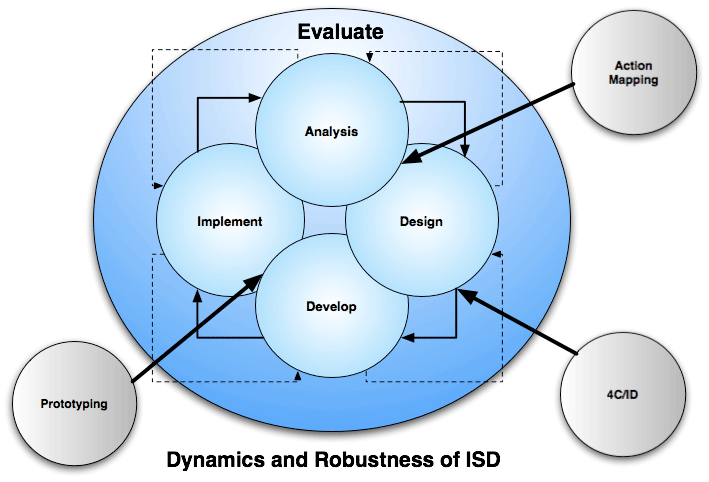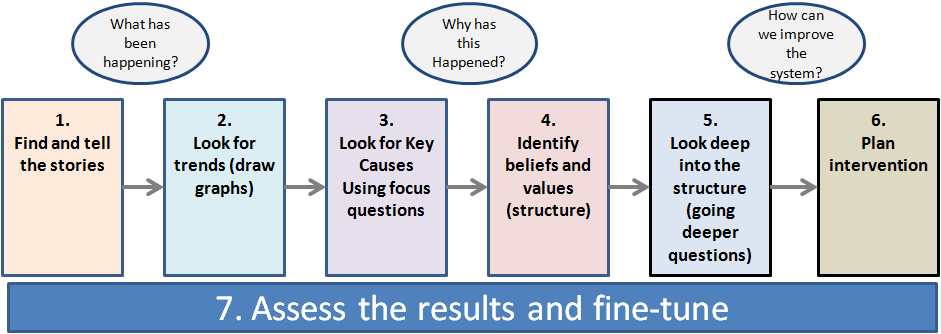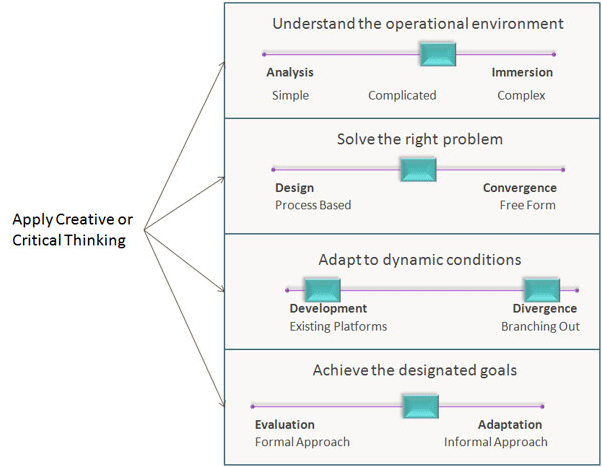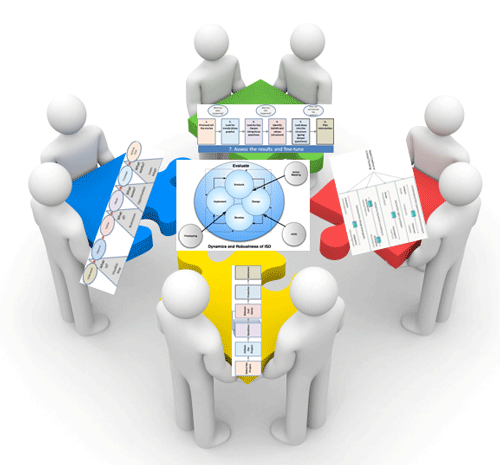| |
ISD or ADDIE |
Design Thinking |
Agile Design |
System Thinking |
X Problem |
Visual Model
click the button below each model for a larger image |

|

|

|

|

|
Definition |
A systematic approach for developing learning platforms. |
Applying critical and creative thinking to understand, visualize, and describe complex, ill-structured problems and develop approaches to solve them. |
A method for breaking tasks into small increments with minimal planning that do not directly involve long-term planning. The iterations are short time frames that typically last from one to four weeks. |
Problem solving by viewing "problems" as parts of an overall system, rather than reacting to a specific part, outcome or event and potentially contributing to further development of unintended consequences. |
Used to solve wicked or complex problems for 21st century challenges that defy conventional planning. |
Primary Values |
Obtains business results through improved performance. |
Focuses on the wider social space of systems and society rather than artifacts and aesthetics by expanding engagement, impact, and sales. |
Builds a vibrant learning environment through communication, collaboration, and small but rapid iterations in order to sustain agility that adapts to a changing environment. |
Uses a holistic approach to goal seeking rather than focusing on independent elements in order to build a systemic interaction that results in a goal or final state. |
Uses extreme adaptive approaches to innovate when solving wicked problems, rather than designated steps that normally do not work well when facing such problems. |
Key Feature |
An older methodology that has rapidly evolved into a robust model for solving more structured problems. |
While focus is primarily on the problem and product, the model does use customer feedback for solving ill-structured problems. |
The model relies heavily on customers being part of the team so that changing requirements can be adapted to. |
Best for complex problems that effect an entire system or organization. |
Used for wicked problems that borders on the edge of chaos. |
Example |
This methodology relies on a viable model to build the design (think of a guru who is the best performer to seek advice from):
You have an Exemplary Performer or a model of one that informs you of how the task or process should be performed. |
This methodology relies on the designers or experts for building a best design (think of the iPad that no one thought they needed until it was available):
There are no models of the task or process so the designers, and perhaps with the help of experts, develop a new task or process. Customer feedback is normally used after the initial model has been designed. |
This methodology relies on customers who have the insight to be major collaborators in the design (think of a complex process in your company that relies on a number of employees and needs improvement):
There are no clear models of the task or process so the customers, designers and sometimes experts collaborate to build a new model. The design is built using small iterations so that the customers can ensure they are getting a viable solution that fits their needs. |
This methodology relies on gaining an understanding of the organization as a whole (think of a complex process in your company that spans several departments or borders and needs improvement):
Similar to Design Thinking in that there are no models of the task or process so the designers and/or experts develop a new task or process. However, it is realized that the solution may have a detrimental affect on a large part of the organization, thus the solution must be fine-tuned to span the entire organization. |
This methodology is used for extremely wicked problems (think of a solution that often brings more new problems than it solves, such as diversity training or a new performance feedback program):
The problem and its solution cannot easily be grasped by the customers, designers or experts. Thus a new set of “eyeballs” work alongside the employees with the purpose of gaining an insight. When a new insight is discovered, a “test” design or solution is tried to determine if it is viable (called a “Design Iteration”). This process is continued until enough viable solutions have lowered the problem to a desirable state. |
| |
|
|
|
|
|
Main Steps or concepts: |
1. Analysis: understanding and then describing the objectives needed to correct performance deficiencies (identify goals) |
1. Apply critical thinking to gain understanding of the problem |
1. Select the project and develop the vision. |
1. Tell stories that focus on a narrative that will aid in discovering the issue. |
1. Immersion: soak yourself in the problem to harvest customer insights and gain empathy. |
|
2. Design: a process to achieve the goals in order to correct the performance deficiencies |
2. Observe to understand the operational environment |
2. Initiate the project by obtaining stakeholder participation, funding, and build team. |
2. Look for trends in performance patterns |
2. Convergence: bring together all things such as physical, technology, software, and services into a logical design |
| |
3. Development: building the initial discoveries into a process that will assist the learners to become expert performers |
3. Solve the right problem by defining it |
3. Deliver small working iterations that meet the changing needs of the stakeholders. Normally uses Release Iterations - although the release may not be fully completed or functional, the designers believe that it is good enough to be of use to the learners or users. |
3. When a trend becomes visible, develop a focus question that describes the context of what you are seeking |
3. Divergence: explore new advantages. Unlike Agile Design, which mainly uses Release Iterations, Problem X mainly uses Design Iterations — the iteration is performed to test a method, function, feature, etc. to a small population of learners to see if it valid. |
| |
4. Implementation: deliver the learning platform |
4. Ideate: imagine or conceive solutions to solve the problem |
4. Release End Game (deliver the final package). |
4. Look for key causes and consequences |
4. Adaptation: stay nimble in a fast-moving environment by going in new directions when facing roadblocks. Use your recent learning's of the problem to help guide your new direction. |
| |
5. Evaluation: ensure the learning and performance platform is delivering the desired results |
5. Adapt to dynamic conditions by prototyping |
5. Production — operate, maintain and support the system |
5. Look deeper into the problem. Are beliefs and values causing the situation to persist? |
|
| |
|
6. Achieve the designated goals |
6. Retirement — remove when no longer needed |
6. Plan an intervention by basing it on your understanding of the structure. What approaches and actions are needed? |
|
| |
|
|
|
7. Assess the results and fine-tune. |
|
Additional Readings |
ADDIE Timeline,
ISD |
Wikipedia entry,
Design Thinking... What is That? |
Agile Design: An Ethos for Creating Learning Platforms,
Getting Real About Agile Design |
Wikipedia entry,
Overview of Systems Thinking |
Extending ISD,
Got X Problems?,
Fresh Trouble |





